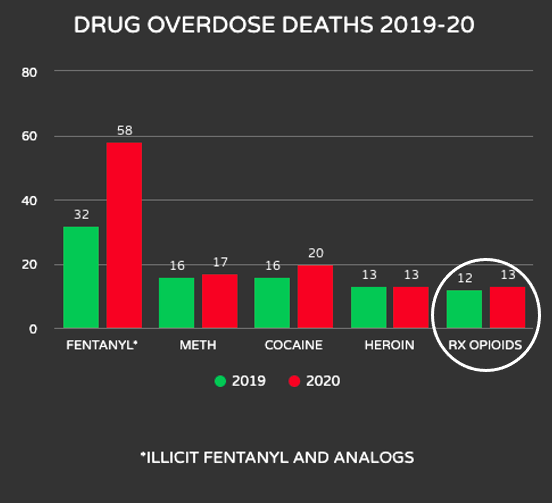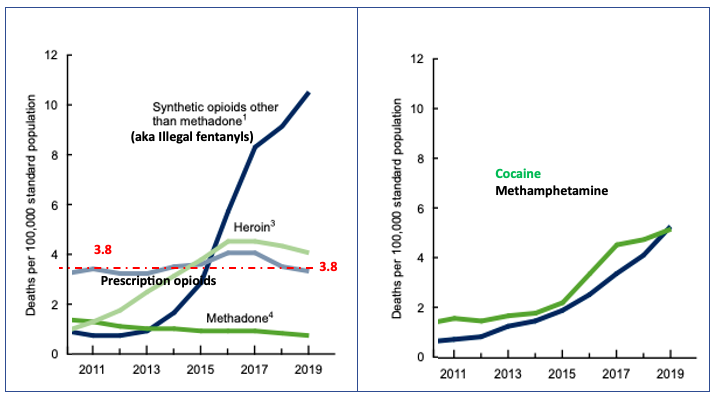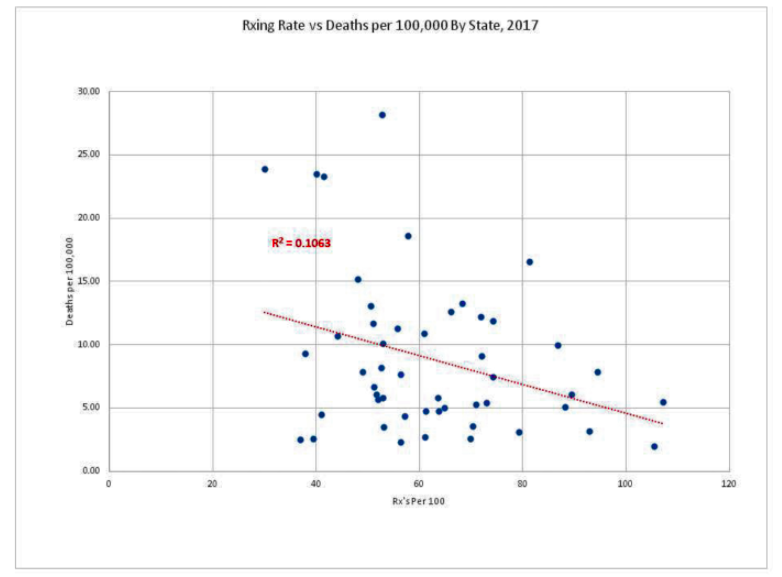It's not at all surprising that CDC data from 2020 shows an increase in drug overdose deaths. Various publications, including The New York Times, and the Washington Post, blame the COVID pandemic, isolation, and stress. The Wall Street Journal blames fentanyl.
All three are probably correct to some extent. The WSJ also notes that the CDC acknowledges that overdoses of methamphetamine and cocaine also rose – a trend that has been ongoing for several years. But what about prescription opioid analgesics ("pain pills,") which still continue to be blamed for the majority of opioid overdose deaths despite reams of evidence to the contrary?
Not a word. This is because the CDC hasn't issued any data on these drugs, at least not in any form where it's accessible.
It's hidden in an excel database containing no fewer than 39,000 cells that cover data for six years. With (more than) a little sorting it is possible to transform it into something that looks like Table 1.

Table 1. Twelve-month tallies of cocaine overdose deaths ending in a given month in the US. I have selected December 2020 (19,511 deaths). VSSR is short for "Vital Statistics Rapid Release."
So, cocaine was responsible for 19,511 deaths during the 12-month period ending in December 2020. The other drugs categorized are heroin, psychostimulants with abuse potential (mostly methamphetamine), synthetic opioids excluding methadone (almost entirely illicit fentanyl and its analogs), and natural & semi-synthetic opioids (prescription drugs like oxycodone, hydrocodone, and codeine). There is no scientific rationale for categorizing drugs in this manner; the CDC is either using bad science or being intentionally confusing in doing so. I previously wrote about how ridiculous these categories are. (See 'Synthetic' And 'Opioids': Two Useless, Confusing Terms That Need To Go).
What About Prescription Opioids and the Others?

Figure 1. Overdose deaths of five classes of drugs of abuse: 2019-20. Deaths are expressed in thousands. Data: DrugAbuse.gov, CDC: Vital Systems Rapid Release: Overdose Death Counts
After locating December 2020 12-month data for other classes of drugs of abuse I graphed it (https://beam.venngage.com/) against similar data from 2019 (Figure 1). The results were anything but surprising.
Almost all of the 30,000 extra deaths in 2020 can be attributed to illegal fentanyl (+26K) – a trend that has been accelerating for years – and to a lesser extent, cocaine (+4K). Of particular significance is that prescription analgesic drugs remained a minor contributor (13.9%) to the total and the absolute number of deaths did not change between 2019-20.
This is Nothing New
It should not be the least bit surprising that OD deaths of opioid analgesic drugs remained stable in the past year. These rates have remained stable for a decade, while deaths from other drugs soared.
Overdose deaths (per 100,000) 2011-2019. The death rate for prescription opioids (red) was unchanged – 3.8 deaths per 100,000 people. During the same time deaths from cocaine, methamphetamine, heroin, and illegal fentanyl all rose substantially. Source: CDC National Center for Health Statistics
Please Explain Why We are Still Focusing on Pain Pills
I (and many others) have written numerous times about the cruel war on pain patients, which is (supposedly) being waged in order to fight addiction and overdose deaths. Barbaric policies and actions like forced tapering, cutting off patients cold, and persecuting physicians for treating pain patients have resulted in nothing but misery and death.
If it's not perfectly obvious by now that opioid analgesic prescription rates and overdose deaths are unrelated how else can you explain the following?

(Left) Opioid prescriptions have been radically reduced since 2011 (Source: Pain News Network), while at the same time (Right), total drug overdose deaths soared. Ignore that blip for 2018. By 2019 the number of deaths exceeded 2017. (Source: CDC).
Or this?

Scatter plot showing a very weak (1) correlation where deaths decline in the presence of increased opioid prescriptions just the opposite of what you would expect if opioid prescribing was the primary driver of opioid-related deaths. Of course, when an R2 value is 0.163 (16.3%, scale 0%-100%) it means that there is little or no correlation between the variables. In other words, the number of prescriptions written in all 50 states in 2017 had nothing do to with the death rate in that state. Credit: Richard Lawhern, Ph.D. The Opioid Crisis in Three Charts.
Finally, Dr. Jeffrey Singer of the Cato Institute (also an ACSH advisor) and colleagues published a 2019 article in the Journal of Pain Research, which also challenges the false narrative that the overprescribing of drugs like oxycodone or hydrocodone is responsible for today's soaring death count. This quote is especially noteworthy: [emphasis added]:
Health care in general, and pain and addiction management in particular, are nuanced undertakings. Current public policies aimed at reducing opioid-related deaths ignore such nuance in favor of ham-handed, empirically dubious, and demonstrably harmful dictates. Americans suffering from chronic pain, and those from whom they receive their treatment, deserve medical care managed through better-informed and more even-handed policy.
Singer MD, et. al, Journal of Pain Research (2019)
NOTES:
(1) Very weak, as in statistically meaningless.



